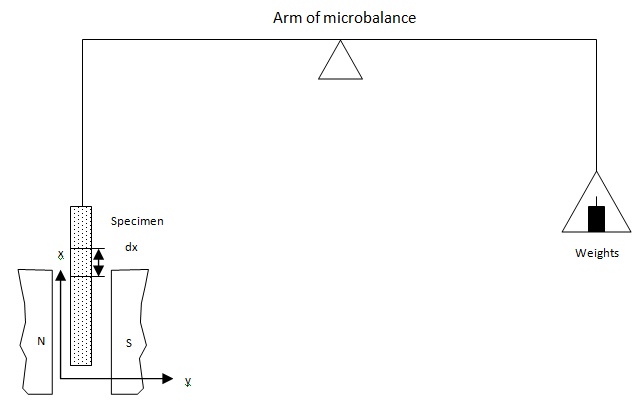Gouy S Method
Gouy S Method Assignment Help | Gouy S Method Homework Help
Gouy’s Method for Measurement of Susceptibility
Apparatus. It consists of an electromagnet having parallel and flat pole pieces with a gap between them. The electromagnet provides a strong horizontal magnetic field of nearly 1 Wb m-2.
The sample under test is taken in the form of a thin rod. It is suspended vertically from one arm of a sensitive micro balance in the magnetic field between the wedge shaped pole pieces of the electromagnet. The specimen is suspended in such a way that its lower end is near the midpoint of the magnetic field where the magnetic intensity H is large while its upper end is outside the field in the region of low intensity H0. The cylindrical rod is then weighed by suspended it from a sensitive microbalance in the two cases:
(i) When field is off. (ii) when field is on.
Theory. Let μ1 and μ2 be the permeability of air and specimen respectively. Consider a magnetic field of intensity H in a region. Let V be the volume of the specimen. Hence the energy of magnetic flux in this region is 1/2 μ1H2V before inserting the specimen and 1/2 μ2H2V, after inserting the specimen. The difference of these energies is equal to the work done is inserting the specimen,
. : Work done = 1/2 (μ2 – μ1) H2V
This is stored as potential energy of field.
Change in potential energy of field,
U = 1/2 (μ2 – μ1) H2V … (1)
We have, μr = 1 + χm or μ/μ0 = 1+ χm
. : μ = μ0 + μ0 χm
Let χ1 and χ2 be the susceptibilities of air and specimen. Then,
μ1 = μ0 + μ0χ1 and μ2 = μ0 + μ0 χ2
. : μ2 – μ1 = μ0 (χ2 – χ1) … (2)
Substituting this in Eq. (1), we get
U = 1/2 μ0 (χ2 – χ1) H2V … (3)
Let Fx be the force acting on the specimen along x-axis. Then,
F = - dU/dx – d{1/2μ0 (χ2 – χ1)H2V}/dx
= -1/2 μ0 (χ2 – χ1) d(H2)V/dx
If Hx, Hy and Hz are components H, then
H2 = Hx2 + Hy2 + Hz2
. : F = - 1/2 μ0 (χ2 – χ1) {d(Hx2 + Hy2 + Hz2)/dx}V … (4)
Now, considering X-axis to be vertical, the vertical force on a small element dx of rod of volume dV, at a distance x from origin is
dFx = - μ0 (χ2 – χ1) [Hx dHx/dx + Hy dHy/dx + Hz dHz/dx] dV
Let α be cross-sectional area of rod. Then,
dv = α dx
. : dFx = - μ0(χ2 – χ1)[Hx dHx/dx + Hy dHy/x + Hz dHz/dx]adx … (5)
In the narrow gap between pole pieces, the magnetic flux will consists of straight lines direct from one pole face to another, in y direction say. Thus only the component Hy will be of significant magnitude while Hx and Hz will be negligible. Hence Eq. (5) is expressible as
dFx = - μ0 (χ2 – χ1) Hy dHy/dz adx … (6)
The total vertical force on the rod due to whole field variation along the length under the limit Hy = H to Hy = H0 is
Fx = - μ0 (χ2 – χ1) a ∫H0 Hy dHy dx/dx
= - μ0 (χ2 – χ1) a ∫H0 Hy dHy
= - μ0 (χ2 – χ1) a [Hy2/2]HHo
= - 1/2μ0 (χ2 – χ1) a (H02 – H2) … (7)
Let m1 and m2 be the weights to counterpoise the force on rod with magnetic field off and on respectively. Then,
Fx = (m2 – m1)g. … (8)
Equation (7) and (8), we get
(m2 –m1)g = 1/2μ0 (χ2 – χ1) a (H2 – H02)
(χ2 – χ1) = 2(m2 – m1)g / μ0 a(H2 – H02) … (9)
H0 and H can be measured by the flux meter. Thus by putting the susceptibility of air χ1 and other known quantities in the above equations, χ2 is calculated.

For more help in Gouy’s Method for Measurement of Susceptibility please click the button below to submit your homework assignment.